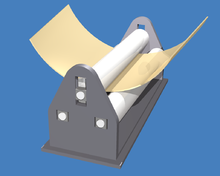
Roll bending
Roll bending
Roll bending produces a cylindrical shaped product from plate or steel metals .
Roll forming
Roll forming, roll bending or plate rolling is a continuous bending operation in which a long strip of metal (typically coiled steel) is passed through consecutive sets of rolls, or stands, each performing only an incremental part of the bend, until the desired cross-section profile is obtained. Roll forming is ideal for producing parts with long lengths or in large quantities. There are 3 main processes: 4 rollers, 3 rollers and 2 rollers, each of which has as different advantages according to the desired specifications of the output plate.
Flat rolling
Flat rolling is the most basic form of rolling with the starting and ending material having a rectangular cross-section. The material is fed in between two rollers, called working rolls, that rotate in opposite directions. The gap between the two rolls is less than the thickness of the starting material, which causes it to deform. The decrease in material thickness causes the material to elongate. The friction at the interface between the material and the rolls causes the material to be pushed through. The amount of deformation possible in a single pass is limited by the friction between the rolls; if the change in thickness is too great the rolls just slip over the material and do not draw it in. The final product is either sheet or plate, with the former being less than 6 mm (0.24 in) thick and the latter greater than; however, heavy plates tend to be formed using a press, which is termed forging, rather than rolling.
Often the rolls are heated to assist in the workability of the metal. Lubrication is often used to keep the workpiece from sticking to the rolls To fine-tune the process, the speed of the rolls and the temperature of the rollers are adjusted.
h is sheet metal with a thickness less than 200 μm (0.0079 in). The rolling is done in a cluster mill because the small thickness requires a small diameter rolls. To reduce the need for small rolls pack rolling is used, which rolls multiple sheets together to increase the effective starting thickness. As the foil sheets come through the rollers, they are trimmed and slitted with circular or razor-like knives. Trimming refers to the edges of the foil, while slitting involves cutting it into several sheets. Aluminum foil is the most commonly produced product via pack rolling. This is evident from the two different surface finishes; the shiny side is on the roll side and the dull side is against the other sheet of foil.
Ring rolling
Ring rolling is a specialized type of hot rolling that increases the diameter of a ring. The starting material is a thick-walled ring. This workpiece is placed between two rolls, an inner idler roll and a driven roll, which presses the ring from the outside. As the rolling occurs the wall thickness decreases as the diameter increases. The rolls may be shaped to form various cross-sectional shapes. The resulting grain structure is circumferential, which gives better mechanical properties. Diameters can be as large as 8 m (26 ft) and face heights as tall as 2 m (79 in). Common applications include railway tyres, bearings, gears, rockets, turbines, airplanes, pipes, and pressure vessels.
Structural shape rolling
Controlled rolling
Controlled rolling is a type of thermomechanical processing which integrates controlled deformation and heat treating. The heat which brings the workpiece above the recrystallization temperature is also used to perform the heat treatments so that any subsequent heat treating is unnecessary. Types of heat treatments include the production of a fine grain structure; controlling the nature, size, and distribution of various transformation products (such as ferrite, austenite, pearlite, bainite, and martensitein steel); inducing precipitation hardening; and, controlling the toughness. In order to achieve this the entire process must be closely monitored and controlled. Common variables in controlled rolling include the starting material composition and structure, deformation levels, temperatures at various stages, and cool-down conditions. The benefits of controlled rolling include better mechanical properties and energy savings.
Forge rolling
Forge rolling is a longitudinal rolling process to reduce the cross-sectional area of heated bars or billets by leading them between two contrary rotating roll segments. The process is mainly used to provide optimized material distribution for subsequent die forging processes. Owing to this a better material utilization, lower process forces and better surface quality of parts can be achieved in die forging processes.
Basically any forgeable metal can also be forge-rolled. Forge rolling is mainly used to preform long-scaled billets through targeted mass distribution for parts such as crankshafts, connection rods, steering knuckles and vehicle axles. Narrowest manufacturing tolerances can only partially be achieved by forge rolling. This is the main reason why forge rolling is rarely used for finishing, but mainly for preforming.
Characteristics of forge rolling:
- high productivity and high material utilization
- good surface quality of forge-rolled workpieces
- extended tool life-time
- small tools and low tool costs
- improved mechanical properties due to optimized grain flow compared to exclusively die forged workpieces








